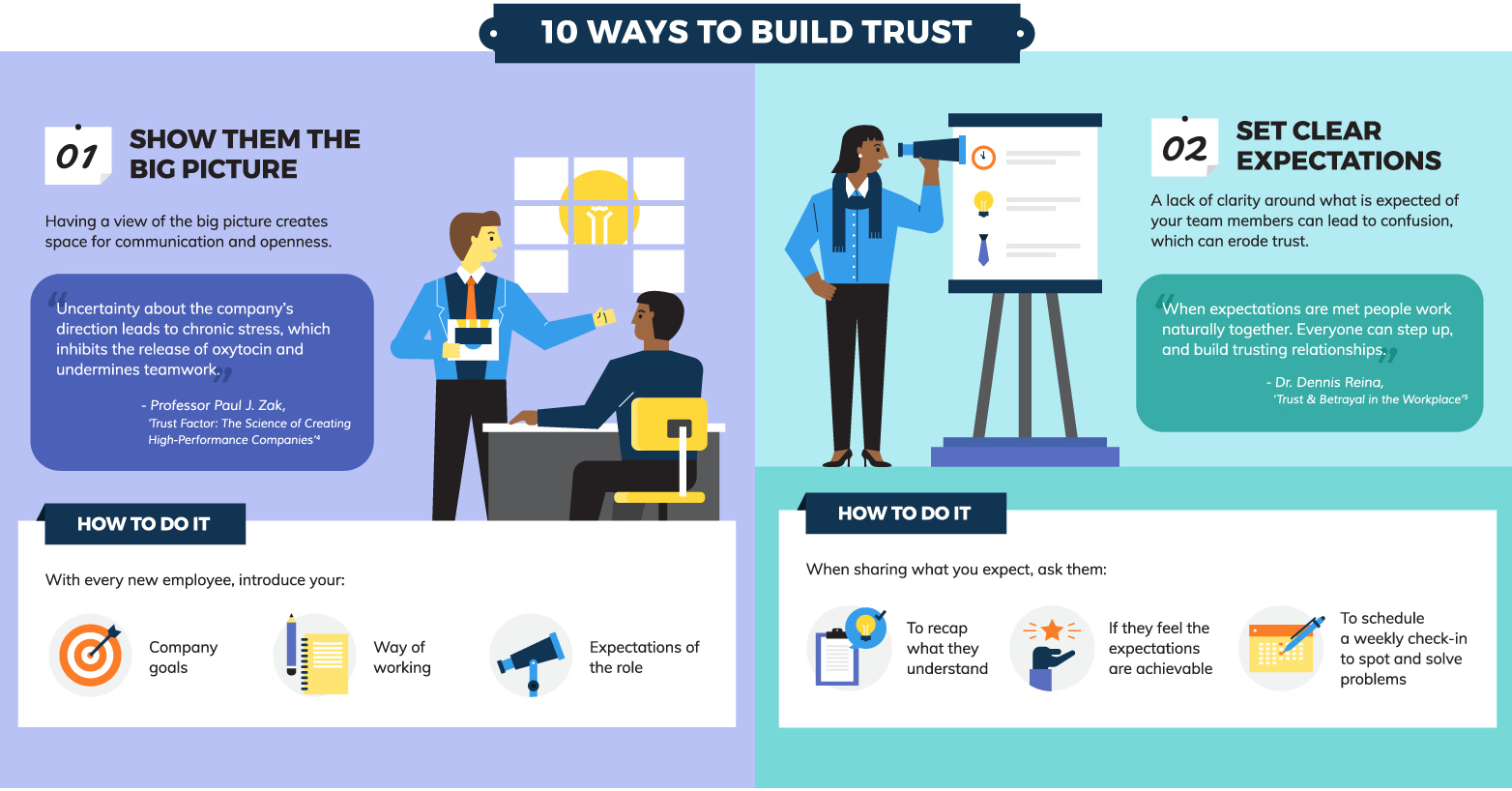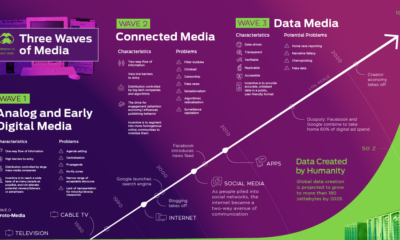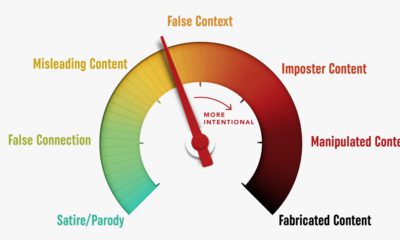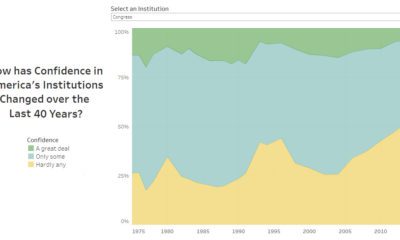Misc
10 Proven Ways to Build Trust With Employees
Making progress towards ambitious and complex organizational objectives can be a tricky endeavor for even the most accomplished of teams.
But if there was ever a surefire recipe to make this undertaking more difficult, it’d be embarking on these kinds of goals with a team that doesn’t actually trust each other.
Not only does trust enable individuals to work outside of their silos and collaborate with other people on the team, but trust is also associated with improved communication, job satisfaction, and higher performance levels within organizations.
The Trust Imperative
Today’s infographic comes to us from The Business Backer, and it highlights 10 proven ways to build trust with employees in teams and organizations.

Many of the complex challenges that dot the modern business landscape cannot be solved by a myriad of solo efforts.
Teams are necessary, and working together cannot take place only at a superficial level. To tackle the big problems, teams must have deep-rooted commitments to each other, creating potential for collaboration, healthy conflict, and differences of opinion.
Managers need to trust employees and vice versa, but different types of teams need to trust each other across other business functions as well.
10 Ways to Build Trust
It’s not possible to build trust with employees overnight, but there are some easy ways to kickstart the process.
- Show them the big picture
Ensuring employees have a view of the big picture creates a space for communication and openness. - Set clear expectations
A lack of clarity of what to expect can lead to confusion, which erodes trust. - Listen actively
Asking open-ended questions like “How’s the project going?” builds trust and respect. - Delegate low-risk projects
A cycle of trust can be created, moving up to bigger and more important projects. - Schedule weekly catch-up meetings
Regular meetings create a trusting environment for people to give and receive feedback. - Be honest
Even when it is uncomfortable, being honest helps build trust and creates healthy conflict. - Commit to your word
Trust depends on integrity, and seemingly erratic behavior undermines this. - Recognize excellent work
This has the biggest effect on trust right after a goal has been met. - Share a bit about yourself
Oxytocin is released in the brain when we socialize and build trust. - Let employees work on projects they enjoy
This allows employees to focus on what they care about most, fostering trust.
Consequences of Inaction
It doesn’t matter how smart or experienced your team is.
Without the element of trust, they will not be able to work together in an effective fashion. For this reason, undertaking a mission to enable and build trust with employees is crucial for the success of any modern organization.
VC+
VC+: Get Our Key Takeaways From the IMF’s World Economic Outlook
A sneak preview of the exclusive VC+ Special Dispatch—your shortcut to understanding IMF’s World Economic Outlook report.

Have you read IMF’s latest World Economic Outlook yet? At a daunting 202 pages, we don’t blame you if it’s still on your to-do list.
But don’t worry, you don’t need to read the whole April release, because we’ve already done the hard work for you.
To save you time and effort, the Visual Capitalist team has compiled a visual analysis of everything you need to know from the report—and our VC+ Special Dispatch is available exclusively to VC+ members. All you need to do is log into the VC+ Archive.
If you’re not already subscribed to VC+, make sure you sign up now to access the full analysis of the IMF report, and more (we release similar deep dives every week).
For now, here’s what VC+ members get to see.
Your Shortcut to Understanding IMF’s World Economic Outlook
With long and short-term growth prospects declining for many countries around the world, this Special Dispatch offers a visual analysis of the key figures and takeaways from the IMF’s report including:
- The global decline in economic growth forecasts
- Real GDP growth and inflation forecasts for major nations in 2024
- When interest rate cuts will happen and interest rate forecasts
- How debt-to-GDP ratios have changed since 2000
- And much more!
Get the Full Breakdown in the Next VC+ Special Dispatch
VC+ members can access the full Special Dispatch by logging into the VC+ Archive, where you can also check out previous releases.
Make sure you join VC+ now to see exclusive charts and the full analysis of key takeaways from IMF’s World Economic Outlook.
Don’t miss out. Become a VC+ member today.
What You Get When You Become a VC+ Member
VC+ is Visual Capitalist’s premium subscription. As a member, you’ll get the following:
- Special Dispatches: Deep dive visual briefings on crucial reports and global trends
- Markets This Month: A snappy summary of the state of the markets and what to look out for
- The Trendline: Weekly curation of the best visualizations from across the globe
- Global Forecast Series: Our flagship annual report that covers everything you need to know related to the economy, markets, geopolitics, and the latest tech trends
- VC+ Archive: Hundreds of previously released VC+ briefings and reports that you’ve been missing out on, all in one dedicated hub
You can get all of the above, and more, by joining VC+ today.
-

 Energy1 week ago
Energy1 week agoThe World’s Biggest Nuclear Energy Producers
-

 Money2 weeks ago
Money2 weeks agoWhich States Have the Highest Minimum Wage in America?
-

 Technology2 weeks ago
Technology2 weeks agoRanked: Semiconductor Companies by Industry Revenue Share
-

 Markets2 weeks ago
Markets2 weeks agoRanked: The World’s Top Flight Routes, by Revenue
-

 Countries2 weeks ago
Countries2 weeks agoPopulation Projections: The World’s 6 Largest Countries in 2075
-

 Markets2 weeks ago
Markets2 weeks agoThe Top 10 States by Real GDP Growth in 2023
-

 Demographics2 weeks ago
Demographics2 weeks agoThe Smallest Gender Wage Gaps in OECD Countries
-

 United States2 weeks ago
United States2 weeks agoWhere U.S. Inflation Hit the Hardest in March 2024














